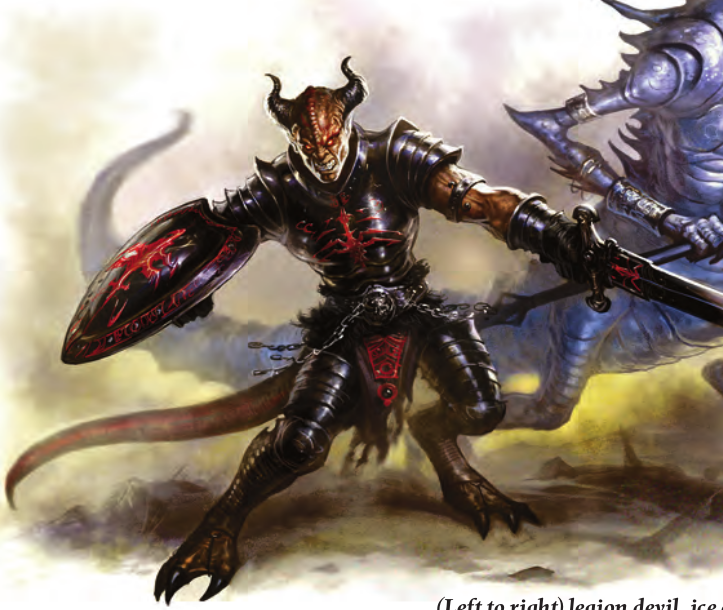Let's Read the 4e Monster Manual/Vault: Legion Devil

This is part of a series! Go here to see the other entries.
The devil entries in both books make frequent mention of the “Legions of Hell”, and now we finally get to see who it is they’re talking about. They exist in both the Monster Manual and the Vault.
The Lore
The creatively named legion devils make up the bulk of those legions. They’re kinda like the perfect ideal of the totalitarian soldier, as they don’t have much in the way of personal initiative or even personality. They live to obey their commanders, and will gladly give their lives if for the glory of Hell ordered to do so.
If you keep following the corporate analogy I’ve been using you’d be tempted to equate legion devils to the many salaried employees who fill cubicles and mail rooms in any giant corporation, but the truth is they’re not very like those people at all. They’re a lot closer to the dystopian notion of a “resource”: numbers on a balance sheet, undiferentiated and replacable. Managers spend them to achieve their quarterly goals and can always get more where those come from. And they’ll never complain about any of this, because they’re happy to serve the goals of President Asmodeus.
In fact, all this grim thinking reminds me of several discussions I’ve been seeing on RPG.net lately where some people say humanoids like orcs and kobolds aren’t acceptable “kill on sight” monsters, while others do a bit of contortion to figure out a scenario where they would be because it’s traditional. Me, I say that if you need an army of faceless minions who are never up to any good and whom you should always fight with all your might, you should drop humanoids entirely and look to these guys. Well, to all devils and demons, really, but fighting devils-as-symbols-of-totalirarianism specifically feels a little more satisfying to me these days.
The Numbers
Legion Devils are Medium Immortal Humanoids (devils), and are always minions. More specifically, they’re minion Soldiers even though the first Monster Manual didn’t assign subtypes to minions.
The Monster Manual gives us Legion Devil Grunts, Hellguards, Veterans, and Legionnaires, which are level 6, 11, 16 and 21 respectively. The Vault has updated versions of the Hellguard and Veteran. All versions in the same book are pretty much identical aside from level, and it’s pretty easy to level any one of them up or down to the exact level you need if none of the ready-made ones is appropriate.
Legion devils are armed with longswords and heavy shields, and wear plate. They have darkvision and a fire resistance of 5 per tier (i.e, 5 at level 1-10, 10 at 11-20 and 15 at 21-30). They run with speed 6 (level 15-) or 7 (16+), and teleport with speed 3 at all levels. They gain a +2 bonus to all their defenses if adjacent to another legion devil.
Their longsword attacks suffer from the damage bug in the Monster Manual versions. The Vault versions fix this, and also do aditional damage to targets that willingly move in their next action. When building your own legion devils, you should use this version of their basic attack.
This indicates to me that despite being expendable minions, legion devils fight in a very coordinated fashion, teleporting short distances to gain combat advantage and using their attacks to keep enemies locked in place and allow their bosses to focus fire on the biggest threats.
The sample encounters in the MM are:
-
Level 6: 4 legion devil grunts, 2 tiefling heretics, 2 tiefling darkblades. Your basic diabolist cult and its summoned muscle.
-
Level 21: 8 legion devil legionnaires, 2 ice devils, and 1 war devil. An infernal princeling and his personal security detail.
Final Impression
There isn’t much actual flavor in the book entry for legion devils, but for some reason they ended up sparking my imagination and giving rise to the rant you see up there in the Lore section. In a game focused on fighting devils, I’d definitely make regular versions of them for use as low-to-mid Heroic tier opponents, and the minion versions would be a constant presence in the rest of the campaign.